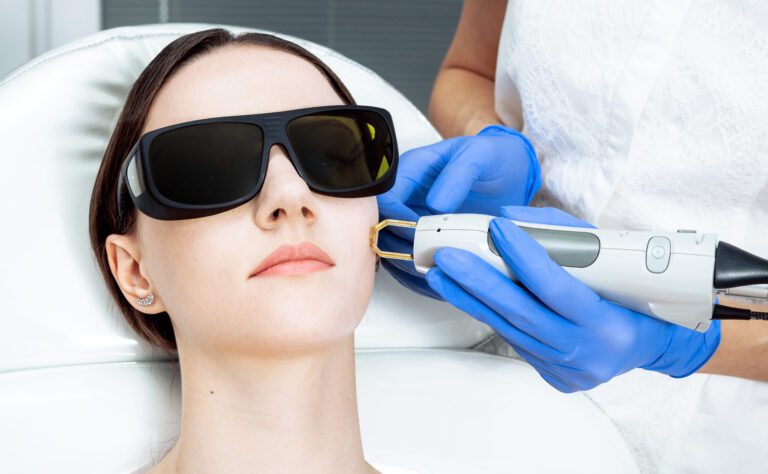The beauty of laser skin resurfacing is that it can treat a wide range of skin problems without a single incision. But being non-invasive doesn’t mean there’s zero downtime. In fact, a few recovery days, ideally with proper post-laser skin care tips, can make the results—and your overall experience—much better.
As a resurfacing, “lasers emit light at different wavelengths to specifically destroy pigment, blood vessels, and damaged skin to improve skin tone and texture,” says Washington dermatologist Tina Alster, MD. In creating these controlled injuries, lasers can leave the skin vulnerable to external aggressors while it heals, not to mention overall irritation. Here’s what you can do before, during and after your treatment to set yourself up for a smooth recovery.
Featured experts
- Tina Alster, MD is a dermatologist based in Washington, DC
- Doris Day, MD is a dermatologist based in New York, New York
- Miguel Mascaró, MD is a facial plastic surgeon based in Delray Beach, FL
Prepare before your treatment
Your post-laser skin care routine should begin before your appointment. “It’s important to prepare the skin to get it in the best possible condition before treatment,” says New York City dermatologist Doris Day, MD, who provides patients with a prescribed skin care routine to follow that includes topical components such as exosomes, antioxidants. and growth factors. (The exact order depends on the patient’s skin type and concerns.) That way, he can ensure that the patient won’t react to any ingredients.
Dr. Alster, meanwhile, will put her patients on a simple skin care regimen consisting of a topical antioxidant, such as vitamin C, followed by a mineral sunscreen. Having healthy skin beforehand will make the healing process go more smoothly.
Stay out of the sun
Of all the post-laser skin care tips, there is none more important than avoiding sun exposure. Going without sunscreen after a laser treatment is like taking two steps forward and one step back. For one: “Your skin can become pigmented and it can take a long time to go away,” says Delray Beach, Florida facial plastic surgeon Miguel Mascaró, MD. (This is even more useless if you’re getting laser treatment for hyperpigmentation, too.)
Additionally, sun exposure after a laser treatment can increase the risk of side effects, such as blistering, according to Dr. Alster. Both doctors recommend using a mineral-based sunscreen in the days following the procedure. “It’s much gentler on the skin and less likely to cause a reaction or sensitivity,” says Dr. Mascaró.
Allow plenty of recovery time
If it’s not invasive, it’s not a big deal – or so you might be tempted to think when you go in for a laser treatment. But this is one of the biggest mistakes patients make when planning their post-laser skin care, Dr. Mascaró says. “You want to give your skin enough time to recover properly for best results,” she says. “The more aggressive the treatment, the more downtime you should give yourself.”
A non-ablative laser like Fraxel will likely require two to four days of downtime, he says. Meanwhile, if you’re having a laser ablative treatment — meaning it completely destroys the top layers of skin — expect to need between one and three weeks of recovery. That said, “it depends on the depth and aggressiveness of the treatment,” says Dr. Mascaró, who suggests following your doctor’s advice closely. Plus, they know what settings were used for the laser, as well as what you can expect in your recovery.
Strategy for your aftercare
Immediately after treatment (and with your doctor’s permission), apply an aloe vera gel. Any kind will do, says Dr. Mascaró, who notes that aloe vera “has an anti-inflammatory component, reducing swelling and improving healing time by about 60 percent.”
For the first seven days after your treatment, moisturize your skin and apply sun protection diligently. Dr. Alster recommends using a mild cleanser twice a day, followed by a fragrance-free moisturizer. (Likes Epionce Medical Barrier Cream.) During the day, use this mineral SPF. If you typically use strong or potentially irritating active ingredients in your routine, like retinoic acid, don’t bring it back until your skin has healed, she says.
Dr. Day also sends patients home with the CO2Lift Carboxy Gel face mask for use on the third and fifth day after the procedure. “It’s like a hyperbaric oxygen treatment at home and does a great job of reducing redness and improving skin hydration,” she says. (The mechanism of action: Oxygen improves microcirculation, which speeds healing, according to Dr. Day.) Consider it an investment to get the most out of your laser treatment—in the form of brighter, firmer, and properly healed skin .


